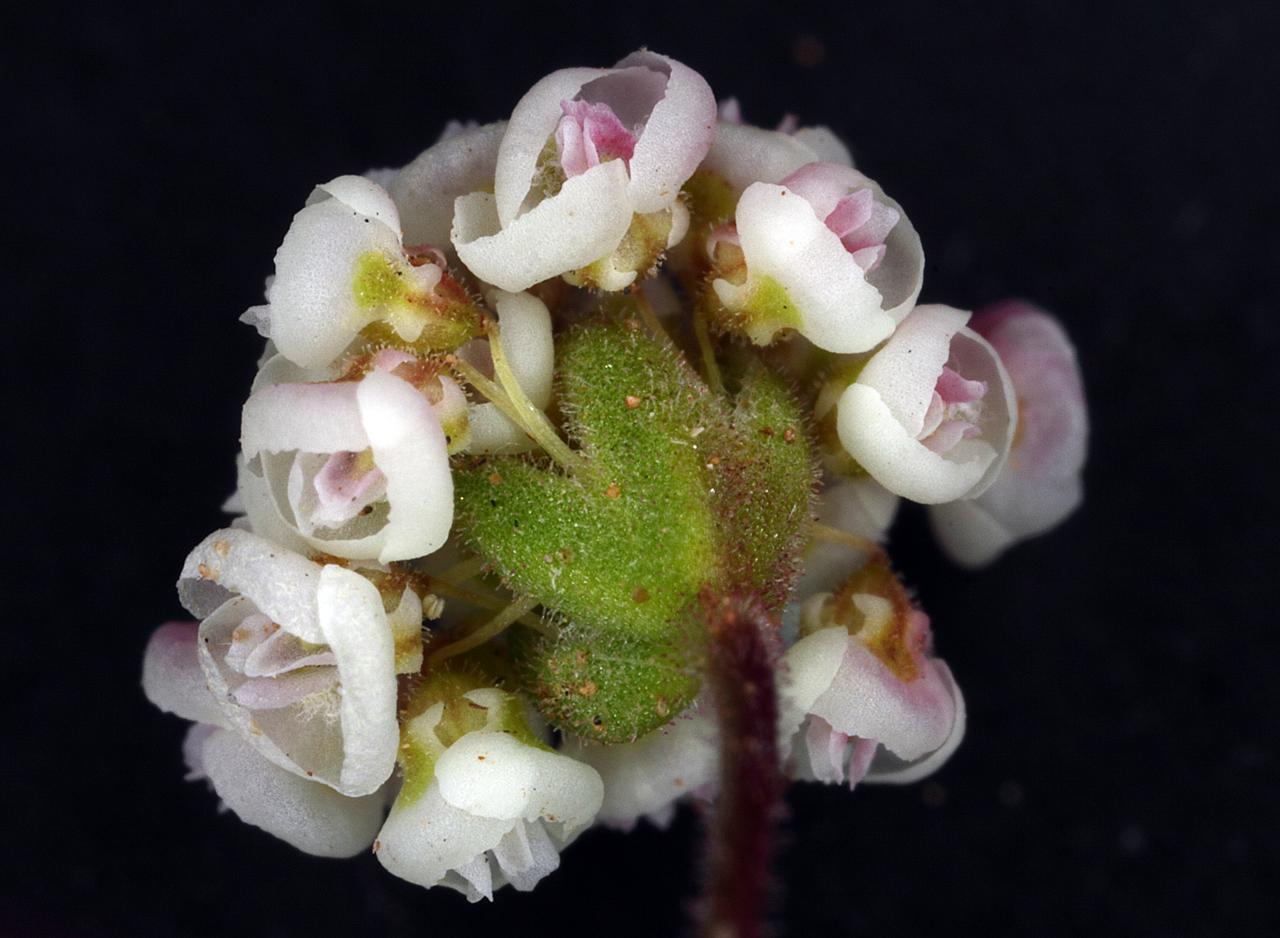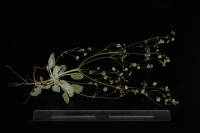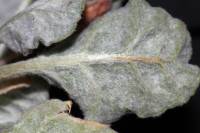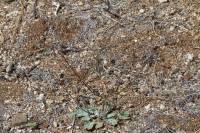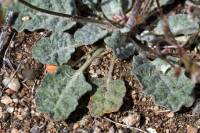|
|
|
|
Family: Polygonaceae
Thurber's buckwheat
|
Herbs, spreading, annual, 0.5-4 dm, glabrate, glabrous or sparsely glandular, greenish, grayish, or reddish. Stems: caudex absent; aerial flowering stems erect, solid, not fistulose, 0.3-1 dm, often sparsely tomentose and glandular proximally. Leaves basal; petiole 1-3 cm; blade oblong to narrowly ovate, 0.8-4.5 × 0.5-3 cm, densely white-tomentose abaxially, floccose or glabrous and greenish adaxially, margins often crenulate. Inflorescences cymose, mostly diffuse, 5-30 × 5-50 cm; branches sparsely glandular to glabrate or glabrous; bracts 3, scalelike, 1-2.5 × 1-2.5 mm. Peduncles erect, straight, capillary, 0.5-2.5 cm, glabrous and glandular-puberulent distally. Involucres broadly turbinate, 1.8-2 × 1.8-2 mm, minutely glandular-puberulent; teeth 5, erect, 0.4-0.6 mm. Flowers 1-1.7 mm; perianth white with greenish or reddish midribs, becoming red, glandular-puberulent with a tuft of long white hairs adaxially; tepals dimorphic, those of outer whorl broadly pandurate or flabellate, those of inner whorl oblanceolate; stamens included, 0.7-1.2 mm; filaments mostly glabrous. Achenes brown to black, usually lenticular, 0.6-0.8 mm, glabrous. 2n = 40. Flowering year-round. Sandy flats, washes, and slopes, saltbush, greasewood, and creosote bush communities, oak, pinyon and/or juniper woodlands, (montane conifer woodlands in Mexico); 100-1200 m; Ariz., Calif., N.Mex.; Mexico (Baja California, Sonora). Eriogonum thurberi is common to abundant but rarely weedy in northwestern Mexico, southern California (Inyo, Los Angeles, Orange, Riverside, San Bernardino, and San Diego counties), and southern Arizona (Cochise, Gila, Graham, Maricopa, Mohave, Pima, Pinal, Santa Cruz, and Yavapai counties). It just enters New Mexico (Grant County). It and E. thomasii are the annual members of the E. cernuum complex typically found on the Mojave and Sonoran deserts, with E. thurberi extending farther to the east and E. thomasii farther to the north. The two occasionally grow together.
Kearney and Peebles 1969, McDougall 1973 Duration: Annual Nativity: Native Lifeform: Forb/Herb General: Annual, to 30 cm tall, stems 1-several from the base, diffusely branching, bearing tufts of fine wooly hairs, at least at the base, glandular pubescence on the involucres, peduncles, and bracts. Leaves: All basal, ovate-oblong, to 3 cm long, glabrate above but densely white-wooly beneath. Flowers: No corolla, the perianth pink or white, 1-2 mm long, the outer segments fan-shaped and somewhat hooded, abruptly narrowed to a claw-like base, the inner ones linear-lanceolate, peduncles very fine, hair-like, to 25 mm long or more, the involucres broadly turbinate, lobed to near the middle, glandular-puberulent. Fruits: Achenes black, to 1 mm long. Ecology: Found in sandy soils below 4,000 ft (1219 m); flowering March-June. Notes: The keys to this species are the glandular pubescence on the hemispheric involucres, peduncles, and bracts, the outer perianth lobes fan-shaped and somewhat hooded, along with the wooly tufts on the bases of the stems, and the perianth white or pink. Ethnobotany: Unknown Etymology: Eriogonum is from Greek erion, wool and phyllon, leaf, while thurberi is named for Dr. George Thurber (1821-1890) an American botanist for the Mexican Boundary Survey. Synonyms: Eriogonum cernuum subsp. thurberi, E. cernuum subsp. viscosum Editor: LCrumbacher, 2011 |
|
|
|


